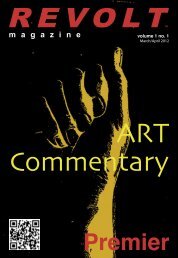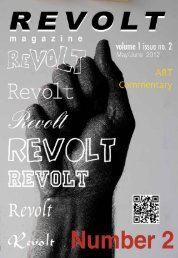Download PDF Version Revolt Magazine, Volume 1 Issue No.4
Download PDF Version Revolt Magazine, Volume 1 Issue No.4
Download PDF Version Revolt Magazine, Volume 1 Issue No.4
Create successful ePaper yourself
Turn your PDF publications into a flip-book with our unique Google optimized e-Paper software.
ARCHITECTURE<br />
VIEW<br />
On Being Post-Sequin<br />
An Interview with Theresa Himmer<br />
BY KATIE CERCONE<br />
Theresa Himmer is a contemporary artist<br />
working primarily with urban installation, video<br />
and sound that splits her time between New York<br />
City and Reykjavik, Iceland. A recent graduate of<br />
the Whitney Independent Study program, Himmer<br />
was included in the Young Artist’s Biennial,<br />
Bucharest in 2012 and has produced extensive<br />
public art projects in Iceland, Mexico and Russia.<br />
Trained formerly as an architect and still very much<br />
informed by the discipline, her work deals with<br />
urban landscape related to diasporic experience<br />
and intersubjectivity, the dynamics of spatial<br />
perception and architecture as a semiotic structure.<br />
You may have seen (and heard) her work<br />
in the elevator of Art in General last spring. For All<br />
State, a 6-hour long site-specific sound installation<br />
she produced for Art in General which is currently<br />
installed at Reykjavik Art Museum, Himmer<br />
scavenged sounds from the given milieu of the<br />
elevator. Utilizing “the crisp bell that marks the<br />
passing of floors, the squeak it makes passing 2nd<br />
and 3rd, the hidden emergency phone’s empty<br />
duut, bellowing doors opening and closing and the<br />
sharp click of the mechanical switchboard in the<br />
engine room on the roof,” Himmer investigated<br />
each sample for its parametric variations in rhythm,<br />
spatio-temporal reverb, tonality and inversion.<br />
As a final score replayed for visitors to the site as<br />
they rode the elevator, All State was a sound wall<br />
weaving an inexhaustible system of variations<br />
layered over the daily noise of the elevator’s utility.<br />
Interested in the border territory suturing<br />
the constructed space of the social with the<br />
veiled reality of the psyche, often her structures<br />
and audiovisual projects are a unique expression<br />
of a type of institutional limbo. In an interview<br />
with <strong>Revolt</strong>, Himmer talks about her recent<br />
installation in Russia, queer and feminist readings<br />
of her practice, her current video project and<br />
why she’s content to see the last sequins of her<br />
Mountain Series in Iceland thrown to the wind.<br />
KC: I’m interested in the interdisciplinary nature<br />
of your work, when did you make the transition<br />
from architecture to art and what was that like?<br />
TH: I trained as an architect and received a<br />
professional degree from an architectural school<br />
in Denmark. Initially when I applied I wasn’t<br />
interested in becoming a “real” architect, I wanted<br />
to go into the set design department. It turned out<br />
REVOLT<br />
<strong>Magazine</strong> Number 4, 2013<br />
that department wasn’t great and I ended up in a<br />
very experimental department that was teaching<br />
architecture in a way that was very open. Somewhat<br />
Bauhaus based, the program was very wide in its<br />
approach to talking about what architecture is or can<br />
be. My thesis was an urban public space landscape<br />
project on the roundabout where the Holland tunnel<br />
exits in Tribeca. I made a park around a grazing field<br />
for the police horses who have their stable around<br />
the corner. That program was my initial training and<br />
then I did practice as an architect for several years.<br />
I learned all the hard-core architectural disciplines<br />
from the initial conceptual phase all the way to<br />
building and detailing practicing with two really<br />
good studios, one in Denmark and one in Iceland.<br />
Of course the practice of architecture proper is<br />
quite different than practicing as an artist, although<br />
I never really feel that I left architecture to go into<br />
art. My artistic practice is coming through and out<br />
of architecture and it is still very much dealing with<br />
architectural disciplines – aspects of place, the<br />
relationship to a context, and the ability to read<br />
a context and insert oneself into that in a special<br />
way. In terms of formal studies there was a point<br />
of transition when I decided to study Fine Arts. My<br />
practice exists in an overlapping space between art<br />
and architecture. Exploring that space from within<br />
an art context during a 2 year MFA program at SVA, I<br />
began to think about the dynamics of spectatorship<br />
and the optic dynamics that are tied to creative<br />
practice in general. After that I spent one year at<br />
the Whitney Independent Study Program which<br />
became a kind of unifying process where I was able<br />
to combine the two sides with a more theoretical<br />
foundation. SVA was quite unstructured in an<br />
academic sense. As a community it was amazing<br />
and as a program it was open enough that anyone<br />
could make of it what they wanted, depending<br />
who you end up studying with and in what groups.<br />
Meanwhile, as you know there wasn’t a lot of theory.<br />
Getting that theoretical and critical foundation<br />
from the Whitney Program was a big step for me,<br />
Double Vision (2012) installation view. Public art project in the city of Perm, Russia. Photo courtesy of the artist.<br />
and then integrating that with my prior knowledge.<br />
KC: Can you explain some of the differences you’ve<br />
noticed in terms of rules and regulations governing<br />
work with structures/public space/buildings in<br />
Europe and the U.S.? Is one more open to a hybrid<br />
and innovative approach to spatial configurations?<br />
TH: I actually haven’t done any public art projects in<br />
the States yet but I have done quite a few in Iceland<br />
which has a Scandinavian kind of logic to the way<br />
things are regulated and I recently finished one<br />
project in Russia. In Iceland it’s very free and easy<br />
to do projects like that. For my first installation in<br />
Reykjavík we didn’t even ask for permissions from<br />
36





